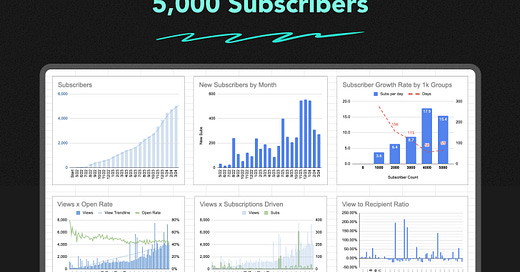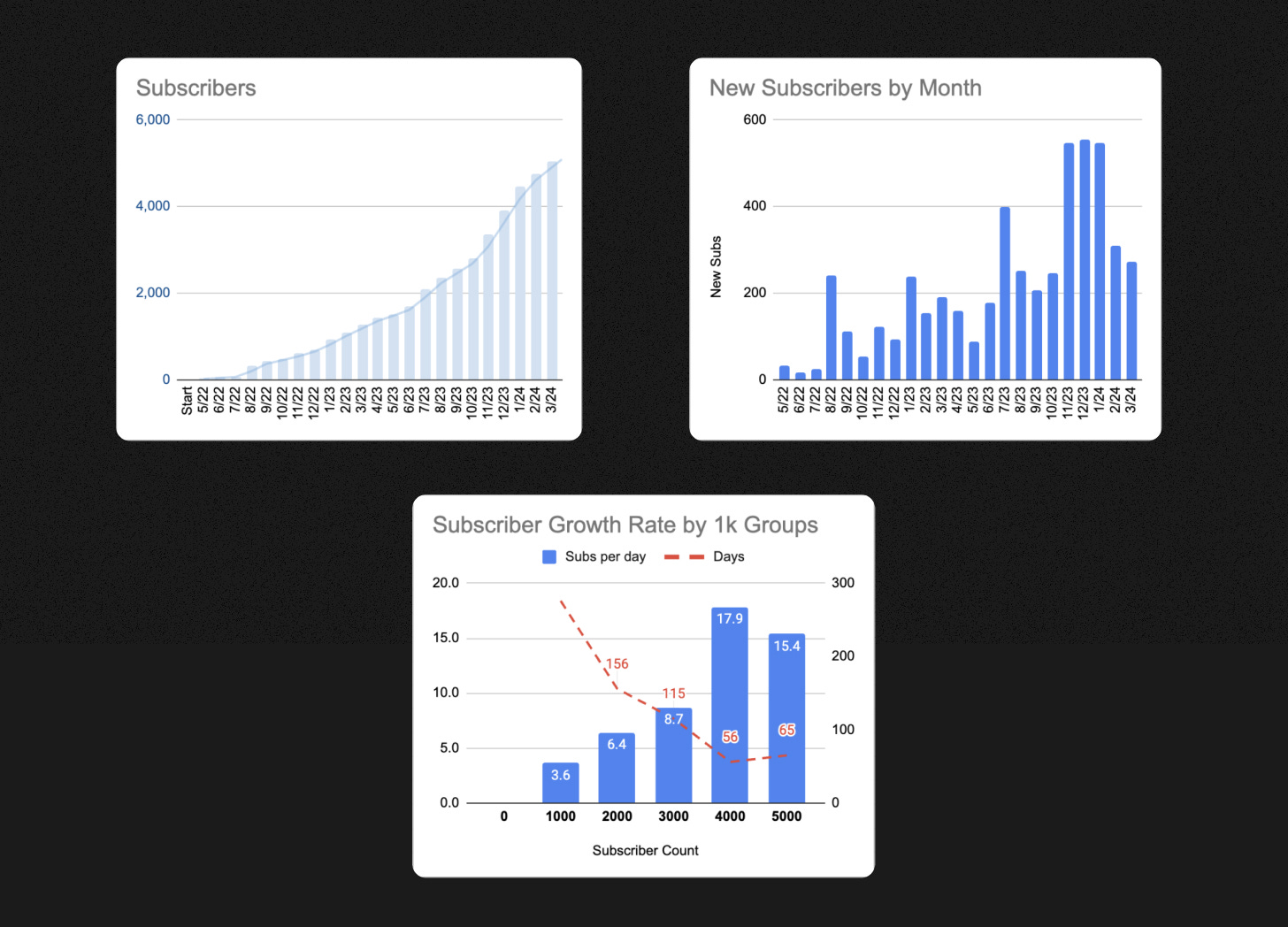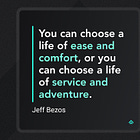Hello! I'm Pat, your guide to the business of creativity and innovation. New here? Join our supportive community to fuel your creative journey!
Hello everyone,
Today I'm back with the sixth publication review.
We crossed 5,000 members this week and it felt like a good time to check in.
A lot has changed in the seven months since the 2,000-member check-in! Many good things have happened but there’s still plenty of uncertainty.
I think I’m nearing a point in my journey that Seth Godin calls “The Dip”: the phase in a creative project where progress seems to stall or decline before reaching success.
As far as dips go, this one seems mild but the feelings are still real.
I feel pleased with the steady growth yet frustrated by my inability to break through to a wider audience.
I feel torn between writing about what interests me versus what drives growth.
I feel ready to get back to creating software but I’m unsure how I want to reintegrate that work into my life.
These aren’t bad problems, but I’m feeling the tension.
I’m entering a new phase.
I broke my writing inertia from zero to 500 subscribers by making a clear commitment.
I fostered the growth from 500 to 5,000 with substantial consistency.
And now I begin the quest for the next order of magnitude from 5,000 to 50,000.
This will demand new strategies and timelines.
In marathon running, there’s a point around the 18-mile mark (29km) where people infamously “hit the wall.” Physiologically, it marks a point where the body runs out of energy without sufficient fueling. Psychologically, it marks a point where, despite already running for hours you confront the fact that you still have almost a third of the race to go. “Hitting the wall” can break you physically and emotionally.
I have strong creative endurance training but the wall beckons.
I’ve gotten ahead of most of the pack but still have a long way to go.
It’s time to refuel and get smart about the long haul.
This is where the real race begins.
In today’s review:
Newsletter Growth Metrics
Social Media Growth Metrics
Operating Expenses
Newsletter Content Review
Top-of-Mind Lessons
What’s next?
Newsletter Growth Metrics
Subscriber Growth
Today’s count: 5,044
Trailing growth: Last 6 months → 13% month-over-month average
Daily growth rate:
2k-3k subscribers → 8.7 subs per day (115 days)
3k-4k subscribers → 17.9 subs per day (56 days)
4-5k subscribers → 15.4 subs per day (65 days)
Trends:
November, December & January were the best months yet. February was slow. March seems to have picked the pace back up.
Open Rate
Average open rate last 30 days: 43.63%
Trends:
This fluctuates from 40 to 48% but has been stable for many months.
Most posts get opened within the next 48 hours after I send them. After that window, open rates slowly increase another percent or two.
The Community
Readers located in: 120 countries and all 50 US States
Number of Substack recommendations: 41 (+19 since last check-in)
Number of subscribers via recommendations: 2000+
It blows my mind how global this community is. I have my work cut out for me if I want to visit every country represented 😅.
A big thank you to everyone who recommends Better by Design on Substack. Your recommendations mean a lot to me and help me a lot! Since I’ve only achieved mixed success on social media, Substack’s recommendation engine has been critical for helping new readers discover my writing. So, thank you for supporting me and continuing to make this project worth the effort every week.
If you have a Substack publication, consider recommending Better by Design! 🙏
Standout Posts
With my current focus on growth, the best way to understand what “good performance” looks like is to answer this question: “Did the post get shared?” If the answer is “yes,” the post tends to bring in new subscribers. If the answer is “no,” it doesn’t. Simple enough. Better shares = better performance.
The three top performers in terms of new subscribers are:
100 Books to Fuel Design Growth - 308 subscribers
This post is a big outlier. First, it’s more of a resource than an essay. Second, I’m using it as a lead magnet to drive new subscriptions. I’m pleased with its performance and seeking ways to replicate its success.
The Era of Design Entrepreneurship - 106 subscribers
I wrote this article last summer, but then the UX Collective featured it as the source for one of the main trends in their annual trends report. That one share shifted the post from being a solid performer to a standout.
10 Heuristics to Simplify Design Decision-Making - 39 subscribers
This recent article is performing well. It makes logical sense to me: a) people love lists and b) people love the promise of shortcuts. A list of heuristics checks both boxes, so I’m not surprised by the performance. Now to decide how to follow up on its success.
Social Media Growth Metrics
X/Twitter
Posts: 433 (~3.3 scheduled posts per day)
Impressions: 3.2 million
Follower count: +61%
In November, I re-started posting daily to X.
It’s the key to driving discovery for my writing.
I’m frustrated that I can’t get many big hits and that it takes so many posts to keep the engine running. But on the bright side, even without major hits, I consistently get solid engagement that does two things for me:
It serves as a testing ground for writing ideas
It acts as continuous research that informs my writing
So, I’ll keep fighting the good fight here and hope the algorithm will reward me one day.
LinkedIn
In January, I started cross-posting tweets to LinkedIn.
The impact has been mixed and very spiky. In January, followers grew 49% due to two posts. Since then, followers have only grown another 6%.
I don’t enjoy LinkedIn much so I haven’t prioritized it. But getting any growth with near zero extra effort by repurposing tweets has been better than nothing.
Operating Expenses
Monthly operational expense: $505.80
Trends:
Soho House is my largest expense, but since it has 1) a coworking space, 2) a gym, and 3) events for creative professionals, it’s well worth it. The second largest expense, Circle, was a Q1 experiment that is ending. So, next month’s expenses will be around $405.
This is a good moment to thank Substack for costing me $0, even after sending 120 articles to thousands of people globally. 🙏
Newsletter Content Review
Posts
Total posts: 120
Average posts per week: ~1.25 posts (~5 per month)
Publishing cadence
After experimenting with different cadences, I settled on one post per week.
In addition to writing, I have to work on social media daily to drive discovery and growth. Social media often feels harder than writing my essay since I enjoy it less. But it’s necessary to achieve what I want to achieve so I suck it up and do it.
When I launch a paid tier it won’t just double the articles. Instead, it will include different bonus kinds of content and other benefits.
Content length
My standard article length is 750-1250 words.
It feels good to me: Long enough for some depth but short enough to read quickly.
However, I think limiting myself to that length might eventually stagnate. It might also not be the best for serving my mission to drive growth.
With that in mind, I plan to experiment with length in either direction.
On the shorter side, I admire the writing of Seth Godin and Derek Sivers. They’re masters at delivering concise creative insights; Sub-500-word brilliance.
On the longer side, I admire Ben Thompson and Packy McCormick. Their in-depth analysis adds a lot of value for me; 3000+ word explorations.
So expect to see me try some sub-500-word and 3000+ word articles in the coming months to see what they inspire.
Series
I’ve tried a variety of series but I’ve paused every one besides the standard blog style.
While readers got value from other formats, they didn’t share the posts. This meant those posts didn’t bring new people to Better by Design.
Anything I publish for free right now needs to have the potential to help subscriber growth. If the data shows that a certain series doesn’t deliver on that, I need to redirect that energy.
The two main examples:
Taste of Quality - This series highlighted the principles behind quality designs (using heuristics like Dieter Rams’ principles to analyze).
I enjoy this series and think it’s valuable. However, these articles haven’t gotten shared or brought in many new subscribers. I had to accept a zero in the growth department for the week to publish them.
I would love to figure out how to revamp this idea to make it work. Maybe it should become more software-centric? Maybe it’s better as a paid-tier offering? Open to ideas!
The Creative MBA - I ran 13 editions of this series as an experiment last spring. It shared short concept explainers across domains I cover: behavioral & social science, design principles, business, technology, and craft.
People liked them but they were a lot of work and didn’t get shared. So, lots of work for little reward equals a no-go.
Again, I think the content is useful but would be better distributed another way. It’s more like course material or executive briefings than shareable Internet content.
Top-of-Mind Lessons
Remembering why I write
In the face of the massive newsletter growth success stories that float around social media, I often feel like a failure.
But when I look at my writing heroes (folks like Seth Godin, Derek Sivers, and Paul Graham), I remember that hacking audience growth isn’t why I write.
I am not building a content product.
I am trying to connect with people and help them through my ideas.
While I care about adding value for my readers and believe I deliver value worth paying for, I do not think of my writing as a product first.
I think of it as expression first, product second.
Focusing on expression first is the only way I can guarantee that I’m willing and able to show up and write week after week for years.
Remembering why I wanted to have a project/business like this
After getting laid off from my job in 2020, I felt the pain of having little I could show publicly for all my effort.
I wasn’t known for anything, had little leverage in my career, and was fully at the mercy of the market. I had to scrounge for opportunities in the endless sea of similar applicants.
I wanted to change that.
I wanted to:
Own my work (something that couldn’t be taken from me)
Have a unique asset that would set me apart in the job market
Create a foundation for the day I want to create my own product
Writing was my way to pursue those goals.
It didn’t need to lead me out of tech forever. It needed to help me feel less vulnerable to employer whims, open new professional doors, and start to diversify my business.
It’s well on its way to accomplishing those.
All that’s left is to see how far I can take it.
The gap between what I find interesting and what drives growth
It’s frustrating how far apart these two sides often seem.
Since I want to grow my subscriber base, I must be aware of what drives engagement and prioritize it. However, the reality is that the content and formats that drive engagement often aren’t the most exciting to me.
There’s a reason you see so many lists and “tips and tricks” online. They just work. They’re high-performing but less intellectually or creatively stimulating.
Hopefully one day I’ll discover a format that excites me AND drives engagement. But for now, I’m torn between two worlds: writing pieces that excite me OR writing pieces that advance my mission to reach more people.
The tension between length vs. insight
In my opinion, business writing value is not determined by length. It’s determined by insight. Usually, this means the most concise, clear articulation of an idea.
However, in the online writing game, long articles seem to get shared more because the market conflates length and insight. Some long articles deserve their length. But many long articles are just… well… long.
In my professional career, no executive has ever asked me to give them a super deep dive on a topic. They pay me to separate the signal from the noise and give them the most important insights as directly as possible.
This puts me in a funny position because I’m better at insights than length.
My experience gives me confidence this is more valuable, but it complicates communicating the value I add to a broader, online audience.
Power law distributions
For most successful online creators, growth follows power law dynamics: most growth comes from a small minority of creations. Hits exist at the extremes.
With that in mind, I’ve probably not taken enough big swings.
This is where playing with content format will come back into play.
I need to maximize the odds of creating a big hit, even if it means sacrificing some of the steadiness of the growth I’m accustomed to.
What’s Next
Getting back into creating products
I don’t know yet whether this will mean working full-time somewhere or opening up my calendar to multiple clients as an independent contractor.
The things I care about most are:
Working on problems that interest me
Working with people who will inspire me and push me to grow
I’m grateful to have reached a point in my life and career where I can say no to any work that doesn’t meet those criteria.
Message me if you have work that might be a good fit. I’m not fully #opentowork yet, but I’m open to conversations and connections.
Preparing to launch a paid tier
I’ve been thinking a lot about how I want to introduce paid options to Better by Design. I’ve invested thousands of hours and dollars into making this project a reality without accepting regular payments. But I think it’s nearing time to introduce that new variable.
In the short term, any financial support I get from readers will go toward covering business expenses and improving Better by Design. Some enhancements just aren’t feasible until I have the revenue to cover the expense.
Don’t worry, I’ll keep the core weekly article free so that all current subscribers continue getting the basics of what they signed up for. Then I’ll add benefits around that core for those willing and able to support me financially.
It’ll be a more Patreon-esque approach. Expect more details about this soon.
If you have specific ideas for offerings you’d like to see, please email me, DM me, or leave me a comment to let me know.
Uncertainty about running a community
I committed to running a closed trial of a Better by Design community using Circle in January. I invited about 30 friends and early supporters to join and test it with me.
I thought I might want to dedicate more time to online community facilitation. Instead, I learned that right now I’m more interested in a) writing more, b) getting back to building products, and c) doing more in-person events in LA.
The best things to come from the experiment were:
Skill-sharing video calls
Facilitated focus work sessions
Supporting the talented folks in this community who are making cool stuff
The good news is that I can do those without introducing another app/inbox to check. Nobody needs more feeds to scroll. I can run what I need via email, Substack, and Luma.
I’m still open to starting a private Discord or Slack as a paid tier benefit. But I’ll only do it if people directly ask for it.
Final Thoughts
Thanks for supporting me on this journey.
It means a lot to me to be able to share my ideas with smart, talented people around the world each week.
Until next time,
Pat
If you got a little value from this post, consider subscribing or sharing. Follow me on X/Twitter and LinkedIn for daily posts.














"The gap between what I find interesting and what drives growth" this point is by far the most difficult one to balance for me too! This was super insightful to read and congrats with the first 5k - up to many more!
Congrats on your continued growth! Love these transparent break downs 👏